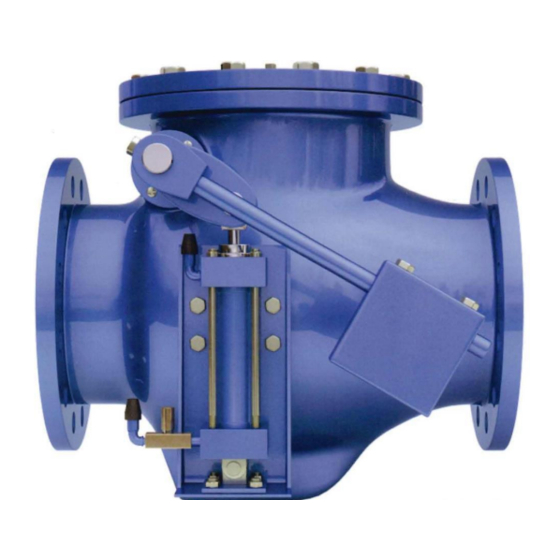DeZurik APCO CVS-6000 Panduan Pemasangan, Pengoperasian, dan Pemeliharaan - Halaman 11
Jelajahi secara online atau unduh pdf Panduan Pemasangan, Pengoperasian, dan Pemeliharaan untuk Unit Kontrol DeZurik APCO CVS-6000. DeZurik APCO CVS-6000 19 halaman. Swing check valves
Juga untuk DeZurik APCO CVS-6000: Panduan Pemasangan, Pengoperasian, dan Pemeliharaan (11 halaman)

DeZURIK
APCO CVS-6000 Swing Check Valves
Adjustment of Flow Control Valve
The Flow Control Valve has a micrometer type adjustment which incorporates a color coded reference
scale to simplify setting, resetting and adjusting.
A set screw on the knob is provided for locking the valve setting. Turning the knob clockwise closes the
valve and turning counterclockwise opens the valve and increases rate of closure of the Check Valve.
Figure 2 – Flow Control Valve
Operation of Internal Cushion
As illustrated below, the cushioning of a pneumatic/hydraulic cylinder stroke is obtained by trapping the
exhaust air/oil as the piston assembly nears the end of its stroke. In Figure 3, as the Cushion Plunger
(1) enters Cushion Cavity (2), the exhaust air/oil is almost completely trapped by the Ball Check (3) and
the Adjusting Screw (4) creating a back pressure against Piston Assembly. The back pressure
cushions and slows the final part of the Piston stroke thus, reducing the high impact hammering of the
Piston Assembly against the Cylinder Cap.
Turning the Adjusting Screw to allow more or less air/oil to escape regulates the degree of cushioning
as desired.
In Figure 4, when air/oil enters the Cylinder Cap End to stroke the Piston Assembly in the opposite
direction, the air/oil moves the Ball Check (3) off it seat, opening the passage for more air/oil to act
against the Piston, thus speeding its start-up movement as the Cushion Plunger (1) is immediately
forced out of its cavity (2).
Figure 3 – Cushion "IN" Stroke
Figure 4 – Cushion "OUT" Stroke
December 2012
Page 11
D12006
